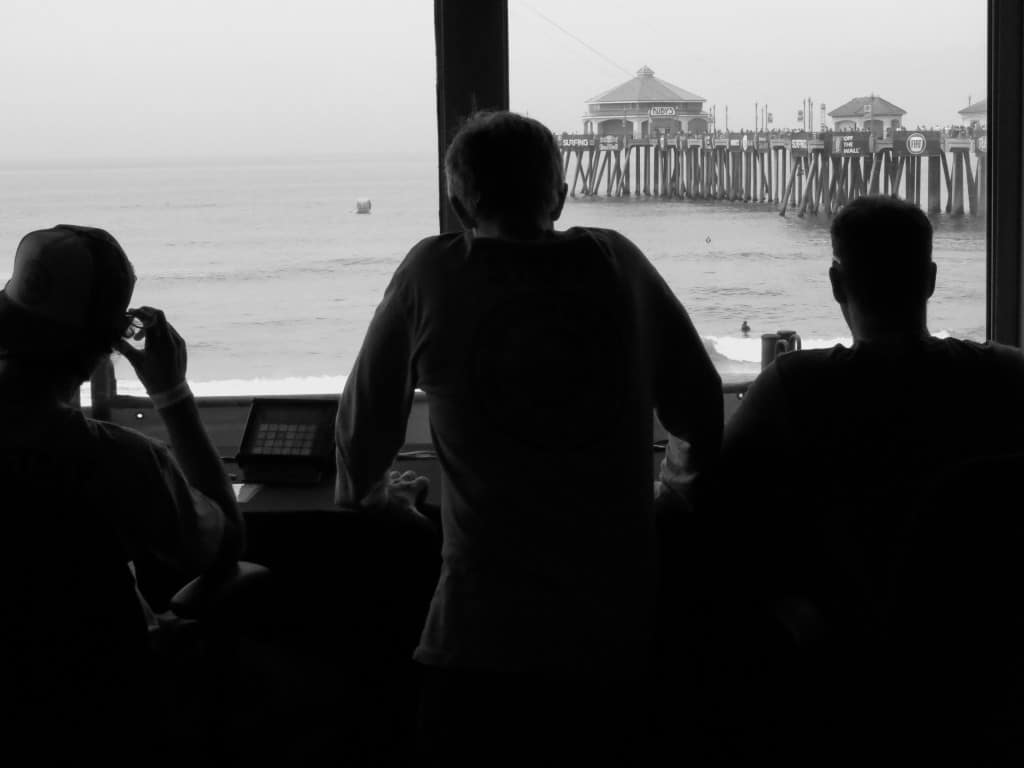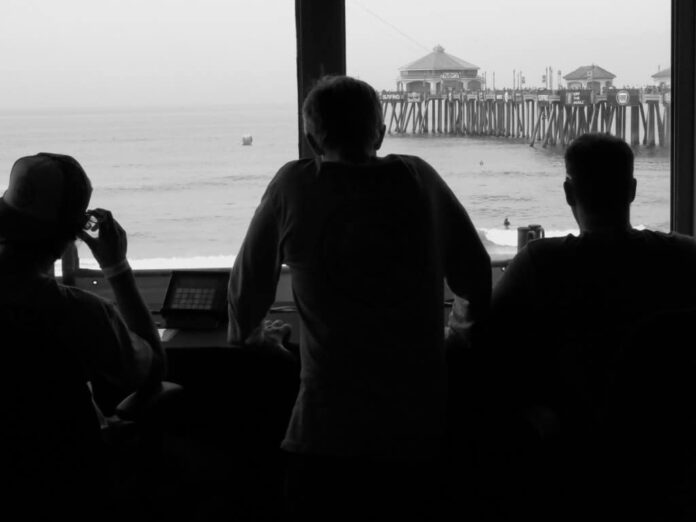
Sex for scores! Cash for priority! Men of power and their cockmongers!
It should be just another bright summer morning in Huntington Beach, California. Golden parcels of light parachute through the roofs and there is no air pollution to clutter the molecules. It is perfect, if you believe in perfection.
But the scene that greets the reporter inside the judging tower resembles Fascist Italy circa 1944. Hello Republic of Salo!
I have been instructed, if I wish to see the judging process, to appear at the bottom of the stairs leading to the great beachfront structure at seven am. No one is there to meet me. I hear laughing (older men), weeping (very young) and some kind of barking, but by humans. I climb the stairs
As I enter what I will later learn is called the “Circle of Overscore”, pro surfers wander naked serving food. Two of the four “studs” or “cockmongers” (a young pro chosen for his large penis) fondle each other in front of the judges, which arouses them greatly.
“I give each of these boys one nine-point-five for two turns and a shorebreak tap per heat,” shouts a judge to much approval.
During a search for the “cockmonger” with the firmest buttocks, the Brazilian Filipe Toledo is chosen and is gifted a win in the US Open, which will conclude the following afternoon.
Could it be true? Is this really how it works? Have the internet commentators been right all along? That the process of judging surfing contests is just a debauched ritual controlled by Men of Power?
Oh how I wish!
What I do find are the loveliest and keenest surf fans you could assemble anywhere. A collection of ultimate surf geeks, although all can surf very well, some at pro level, but ready and skilled enough to compute the difference between rides that may vary by 1/100th of a point. Hair splitting as a profession! It is a relentless job that gives no respite and, to the larger surf world, may seem entirely joyless. But these men love it!
There is Richie Porta, the ASP head judge (although he has two associate head judges, Pritamo Ahrendt and Dave Shipley, that rotate through the Head Judge position at World Tour events). He’s at the US Open more as an overseer and occasional judge than in any super serious role. That’ll come at the contest in Tahiti in a couple of weeks. Of the difference between the US Open qualifier and the World Tour event, he says, “It’s like going from club football to the AFL grand final. The pressure and the nuances at the very top is remarkable. It’s that much more intense it’s not even palpable… Like, last year at Pipe. You’ve gotta have nerves of steel when it’s a game of nines. All the boys are ripping and it’s you deciding, is that nine-two better than that nine-three. At the level of the World Tour it’s that crucial.”
Next is Jeff Klugel the silver-haired former pro surfer who is head judge of the men’s heats here. He roams up and down the panel of five judges, asking the video operator to cue up various rides and says things like, “I like it, I like it. But let’s watch yellow again for a reference, the sections aren’t as critical; blue’s attack looked a little more critical in my mind!”
Rich says, “The coolest thing is, we’re all dyed-in-the-wool surf fans. I love these comparisons.”
Jeff looks at me, bouncing on his feet, and says, “At the highest level, it’s gold! Pure gold!”
The surf is two feet and will shrink toward the shore as the tide comes in. I want to find out how hard, or easy, it is to judge at an ASP event. It ain’t World Tour, I know, but it’s close. And at home my scores reflect, generally, what the judges punch in.
First heat. Mitch Crews versus Charlie Martin. A split peak. Mitch does two little tags, but with style; Maxime Huscenot, three, but with slightly less zing. I give Max a four and Mitch a three-point-eight.
I’m horrified to see the scores come in at seven and five-point-one-seven. Ah, but then I learn. You judge according to the conditions. If you score too low, says Rich Porta, “You’ll compress everything under five. We talk about opening up the scale in bad surf. Say, the surf is good in the morning and the tide comes in and wrecks it in the afternoon, like in France, Portugal or here at HB. We still have to score it out of 10, no matter what. But what would’ve been a four in the morning is now a six.”
Anyway, it’s a game of comparisons, Rich explains, and that it doesn’t matter if your scores are different to the other judges so long as you’re consistent within the heat. The highest score and lowest score is always removed thereby creating a consistent result.
Mitch swings an air. It’s not necessarily that much more difficult than the two safe backhand taps Max has just completed but there is a greater margin for error. I give it a six. It’s a three-point-six-seven.
“Eight years ago that would’ve been an eight-five, now he gets a 3.67,” says Rich. “He didn’t rotate hard, there wasn’t the trajectory in the air. The tour surfers came to us and said judge us on technicality, height and landing. Before it was ‘jump’ and get a score.”
As we get deeper into the first heat, it becomes even more of a game of comparisons. We compare Mitch’s three-six-seven air to his first wave, the five-one-seven (two turns) and three-point left that consisted of one turn.
“It’s crucial to have those smaller waves in the right spaces,” says Rich. “The surfer will come in and say, ‘My air was better than my turn at the pier…were you watching? Surely you guys know that was harder to do!’ So we don’t get flippant with our scores.”
Jeff, meanwhile, is like a conductor, spinning past the judges mounted on their pedestal chairs and punching scores into their electronic boxes that may or may not be replaced by computer tablets soon.
“Let’s go to the replays!”
The replays on a smallish television controlled by a full-time video guy are brutal. What looked rad in the water is compressed on the screen. It explains a lot about why so many people lose it at home. Rich says that most judges have their scores already in their heads and they generally don’t tweak it too much after any replays on the small television screen.
The heat finishes. “Alright!” hollers Jeff. “One done!
“You’re always comparing it to that first score,” says Dylan Feindt, an American judge.
I’m sweating. It’s tough, even one heat, so much concentration my brain aches. As the day move on my scores close in to the paid judges, but occasionally I’ll be blown away by equal scores being given to three re-entries (Brett Simpson) and Felipe Toledo (two airs, including a genuine how-the-hell-did-he-do-that-rote in the shore break).
“When we started everyone surfed the same, you were comparing apples with apples,” says Rich. “Now you’re comparing apples to oranges to bananas and watermelons. If the surfers were to say, all we want you to score is airs, then that’s what we’d score. But it’s all kinds of surfing and the scores reflect it. If you’re not across the concept it doesn’t make sense.”
As for corruption and being blinded by a personal fav, Rich says: “I don’t care who is out there. My focus is on whether or not it’s a six or a seven or whatever and if the surf is good enough to compete.”
(Editor’s note: This story first appeared on the opening day of BeachGrit in 2014. Given the heat surrounding judges, more noise than a football coach, I figured it deserved a little re-run.)
.





